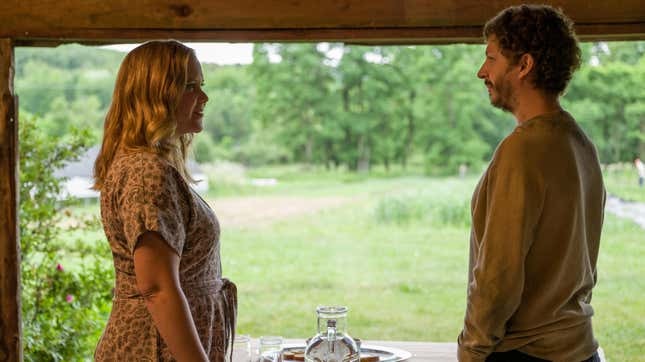#Canada needs clean-air shelters—and quickly


(Photography by CP/Angela Gzowski.)
In mid-July, Toronto clinched the top spot on a global ranking of cities with the worst air quality thanks to rampant wildfires, but throughout the summer, cities all across Canada weren’t faring much better. Communities coast to coast recorded dangerously high levels of smoke and airborne chemicals. The damage wasn’t contained, either: emissions from Canada’s fires tanked air-quality levels as far away as the U.S. and western Europe.
To help citizens breathe easier, some Canadian towns—like Renfrew, Ontario—converted public facilities into clean-air shelters, buildings with air-filtration systems robust enough to keep harmful particulates at bay. Courtney Howard, an emergency-room physician, health policy worker and wildfire researcher based in Yellowknife, says the federal government’s official guidance on setting up clean-air shelters (published in 2020) is a good start. But more needs to be done to make sure Canadians can actually access them as breathable air becomes an increasingly precious resource. Here, she explains what it’ll take to get these shelters off the ground.
Evacuees are just starting to return to Yellowknife. Are you settling back into the swing of things?
Emergency-room services are ramping back up now. The first thought I had when I woke up this morning was, Oh, the kids need school supplies! I wonder if the people who run the store have returned to town yet. My family lives on the shores of Back Bay, and I’m still looking out at a very smoky day. The air quality index was 10 yesterday. Up here, we never really had to use air conditioning before. If it got hot, we just opened the windows. We can’t do that now.
MORE: How the wildfires are affecting our health
This fire season was—I hate to use this term—unprecedented throughout Canada, especially up in the Territories. But you’ve been researching the health effects of smoky wildfire seasons in the North for almost a decade. What have you found?
I’m an emergency physician now, but I’ve been working in the North on and off since I was a resident. In 2014, Yellowknife had one of the worst (and longest) urban smoke exposures ever recorded. After that, I worked on a study in partnership with the Yellowknives Dene First Nation and researchers across Canada that looked at that season’s impacts from a respiratory health perspective, as well how it felt for locals to live through it.
The data showed a full doubling of ER visits for asthma over the course of two and a half months, plus a 50 per cent increase in pneumonia. Some of our community pharmacies ran out of breathing medicines. In video interviews with First Nations residents, many said they felt isolated and disconnected from the land, and were suffering from eco-anxiety. However, the people who were most prepared felt the best—those who fire-smarted their homes, organized boats (in case the highways were blocked) and set up clean-air shelters.
Back in 2014, Mark Heyck—then Yellowknife’s mayor—waived fees at a local fieldhouse so residents had somewhere to go to breathe smoke-free air. Renfrew did the same this year when wildfire smoke floated down from Quebec. What criteria does a building need to meet to be classified as a clean-air shelter?
Any public building can be one provided that its air-filtration system can filter out really high levels of particulate matter. At minimum, it would need to be able to purify the air to below the World Health Organization’s standard for PM2.5, the chemical found in wildfire smoke. (For reference, that standard is less than five micrograms per cubic metre inside, no matter how high the levels are outside.) Malls, schools, community centres, rec centres and libraries could all become designated shelters. Rec centres are especially good because people tend to get really cranky from not having enough physical exercise during smoke episodes. That said, not all of those facilities are accessible.
How so?
The people who are most vulnerable in smoky situations are the ones without homes. It’s unlikely they’d be able to pay the cost of admission for a rec centre. Waiving those fees during air quality warnings is really important. Unhoused people also have higher rates of substance abuse and mental health issues, and as a result, aren’t often welcomed into public spaces. We have to make sure the staff working in clean-air shelters are trained to be sensitive to those issues, and that people have somewhere to go, regardless of their socioeconomic status.
Right now, clean-air shelters are opened on an ad hoc basis. There are no provincially regulated alert systems in place, nor is there a way of communicating which shelters are open to the public. You’d like a formalized policy put in place. What would that look like?
Canadian cities need to have an automatic trigger that activates all designated clean-air shelters—and makes them free to use—once an area’s air quality sits within the “moderate” range for more than two days in a row. (We know that there’s no safe level of exposure to particulate matter, which is why we should keep that threshold pretty low.) That waiving of fees would also need to be planned in advance. That means municipalities would either have to raise those funds themselves or get funding from the provincial and federal governments. The exact amount is a moving target, but it’ll have to be factored into budgets going forward. We’re only going to see more wildfires every year as temperature and precipitation patterns change. Those conversations should be happening now.
Smoke episodes can be especially challenging for public workers, like librarians, who aren’t expecting their workplace to be used as a shelter. We’ll have to make sure they have adequate capacity to handle that. Workers in most public spaces in Canada are usually trained in first aid, so they’d already be equipped to help with medical emergencies or know when to call emergency services.
The buildings themselves will have to have their infrastructure upgraded, too.
It would be best to outfit all public buildings with really strong air filtration systems. There are two reasons to do that—one is wildfire smoke and the other is COVID. It’s airborne and it hasn’t gone away. We need to keep people safe from respiratory illnesses. This is especially true heading into virus season.
Funding the upgrades needed to operate clean-air shelters might be a challenge considering many community centres are already grasping for enough money to keep their doors open (libraries, especially). Do you think this will change as these buildings begin to pull double duty?
Absolutely. In order to keep Canadians safe during the climate emergency, we need to explicitly prioritize initiatives that support wellbeing—from the federal level down to the provincial and municipal levels. We all need to be pointing in the same direction.
I think most people understand that not every Canadian home has air conditioning or industrial-grade HVAC. I don’t think most people realize that even standard air filtration systems can’t contend with the kind of smoke that comes along with wildfires.
People don’t get this—even doctors don’t understand this. Fewer than 20 per cent of medical students have been taught about the effects of air pollution. I certainly wasn’t taught about it. That means we have an entire practising cohort of physicians who can’t counsel their patients on how to deal with it, let alone prepare their homes for it. We keep hearing the phrase “once-in-a-lifetime” from politicians who clearly haven’t looked at the climate graphs. We need to have discussions around mitigation. And people need to know if it’s worthwhile to purchase an air-filtration system for their house. This kind of smoke isn’t a one-off; this will be life for the next 20 years.
Is there anything that individuals and families can do to improve air quality—wherever they live—while waiting for clean-air shelters to catch on?
My husband and I bought a couple of Dyson standing air purifiers after two smoky summers; we quickly realized that wasn’t enough to lower particulate levels in our house and bought a third. I’ve seen a few studies that looked at the usefulness of funding these sorts of devices for people who can’t otherwise afford to buy them, or who have certain vulnerabilities, like asthma or chronic obstructive pulmonary disease. That’s something to consider.
What about options for people who can’t afford to go the Dyson route?
One simple thing you can do pretty quickly is adjust your home’s air intake. When the air outside is smoke-free, open all your windows to clear out any stale air from inside. Make sure your intake is taking in good, clean air from outside. Then, when the wildfire smoke rolls in, close all your windows and reverse your intake so it’s only recirculating your indoor air.
There are other options, too: I was actually talking to a guy this morning who had jerry-rigged an air filter onto a box fan. So there are portable options out there. Along with many other Canadians, my husband and I are also considering buying a heat pump, which work relatively well in weather conditions above -15. They offer a cooling effect in the summer and decrease the amount of heating oil used in the winter. It’s a good option in an area like Yellowknife, where most people’s house have tons of insulation and triple-paned windows. If it’s smoky, and you can’t open your windows in the Land of the Midnight Sun—wow, it gets hot.
MORE: The Age of Wildfires
Conversations about air quality seem to have evolved into conversations about air equality. What I mean by that is: housing unaffordability is now accepted as an unfortunate fact of living in Canada. But it’s shocking to realize that, as a result of climate change, not every Canadian can even afford to breathe. Where do we go from here, policy-wise?
It’s going to take more than building clean-air shelters to keep vulnerable people safe; we’ll also need to provide adequate housing. A lot of the housing stock in First Nations communities, for example, is not of good quality. And if your building envelope is leaky, you’re going to see particulate moving inside from outside at a much faster rate.
These wildfire summers will continue to worsen until at least mid-century, based on the emissions already in our atmosphere. My patient population has seen the impact of climate change sooner than the rest of Canada, and at triple the rate of the rest of the world. I started talking with Yellowknife’s mayor about air quality policy back in 2014, but we’re all going to have to have discussions about what is and isn’t working going forward. We have to ask ourselves: how can we support everybody in terms of health, mental health and financial resources? And most importantly: what are our plans for next summer?
If you liked the article, do not forget to share it with your friends. Follow us on Google News too, click on the star and choose us from your favorites.
For forums sites go to Forum.BuradaBiliyorum.Com
If you want to read more News articles, you can visit our General category.




